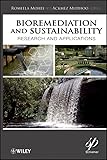Bioremediation and sustainability : Research & Applications
Published by : WILEY (NEW DELHI) ISBN:9781118062845. Year: 2012| Item type | Current library | Collection | Call number | Status | Date due | Barcode |
|---|---|---|---|---|---|---|
 Books
Books
|
KUFOS Central Library General Stacks | Non-fiction | 628.1/683 MOH/BI (Browse shelf(Opens below)) | Available | 15437 |
Browsing KUFOS Central Library shelves, Shelving location: General Stacks, Collection: Non-fiction Close shelf browser (Hides shelf browser)

|

|
No cover image available No cover image available |

|

|

|

|
||
| 628.1/68 SOU/MA Marine organisms as indicators / | 628.1/68 SUF/AQ Aquatic humic substances : Influence on Fate and Treatment of Pollutants | 628.1/680287 AQ Aquatic toxicology and hazard evaluation : | 628.1/683 MOH/BI Bioremediation and sustainability : Research & Applications | 628.1/684 HAY/AG Agriculture, hydrology, and water quality / | 628.1/686762 AEO/ME Metallic effluents of industrial origin in the marine environment : | 628.1 ESL/HA Handbook of engineering hydrology : Fundemen and Application |
Machine generated contents note: Dedications Preface Acknowledgements Editor List of Contributors Chapter 1. Elements of Sustainability and Bioremediation Ackmez Mudhoo and Romeela Mohee Chapter 2. Natural Attenuation R. Ryan Dupont Chapter 3. Anaerobic Digestion Processes Steven I. Safferman, Dana M. Kirk Louis L. Faivor, Wei Wu-Haan Chapter 4. Biosurfactants: Synthesis, Properties and Applications in Environmental Bioremediation Ramkrishna Sen, Ackmez Mudhoo and Gunaseelan, D. Chapter 5. Phytoremediation: An Efficient Approach for Bioremediation of Organic and Metallic Ions Pollutants Divya Gupta, Lalit Kumar Singh, Ashish Deep Gupta and Vikash Babu Chapter 6. Bioleaching Leo G. Leduc and Garry D. Ferroni Chapter 7. Biosorption of Heavy Metals - New Perspectives Teresa Taveres and Hugo Figueiredo Chapter 8. Biofiltration: Essentials, Research and Applications Smita Raghuvanshi, Subhajit Majumder and Suresh Gupta Chapter 9. Modeling and Implementation of Sustainable Remediation Based on Bioventing Hillel Rubin, Eran Rubin, and Holger Schüttrumpf Chapter 10. Bioremediation of Xenobiotics Kamal Saxena, Gajendra Kumar Aseri, Ashish Deep Gupta and Vikash Babu Index.
"Sustainable development requires the development and promotion of environmental management and a constant search for green technologies to treat a wide range of aquatic and terrestrial habitats contaminated by increasing anthropogenic activities with the main sources of contaminants being the chemical industries. Bioremediation is a technique that uses living organisms in order to degrade or transform contaminants into their less toxic forms. It is based on the existence of microorganisms with capacity to attack the compounds on the enzymatic level. Bioremediation is an increasingly popular low-cost alternative to conventional methods for treating wastes and contaminated media with the possibility to degrade these contaminants using natural microbial activity mediated by different consortia of microbes. Over the last few years, the scientific literature has revealed the progressive emergence of various bioremediation techniques. BIOREMEDIATION AND SUSTAINABILITY: Research and Applications presents an up-to-date and comprehensive collection of chapters prepared in bioremediation technology research and application.The strategies covered in this volume can be applied in situ or ex situ, depending on the site in which they will be applied. In situ is the treatment done in the site of the contamination and ex situ involves the removal of soil or water to subsequent treatment. There is a wide variety of techniques that have been developed in the past and are covered in this volume, such as natural attenuation, bioaugmentation, biostimulation, biosorption, composting, phytoremediation, rhizoremediation and bioleaching"--
"Covers the most cost effective techniques in bioremediation technologies and the most cutting-edge research on bioremediation and its applications. Discusses the sustainability paradigm and the role of "green" bioremediation technologies in environmental science. Presents the most important emerging areas dealing with bioremediation, such as anaerobic digestion biotechnology, air-sparging, vermistabilization, bioleaching, biobleaching, and many others. Useful as a textbook, as well as a useful volume for the experienced engineer or scientist working in the field"--


There are no comments on this title.